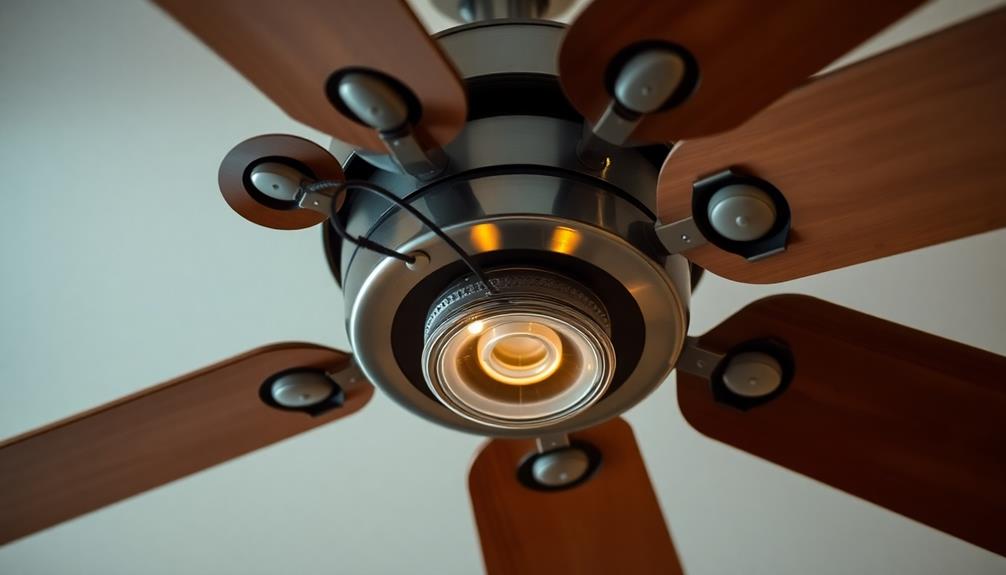If the humming of your ceiling fan is causing annoyance, it is important to identify the source of the problem. Typically, this sound is a result of loose parts such as screws or bolts. Blades that are out of alignment can disrupt airflow and result in increased humming. It is crucial not to disregard motor issues, as worn bearings can also contribute to the noise. Factors such as the environment and electrical issues like power surges can also be factors. Performing regular upkeep, such as tightening screws and cleaning blades, can significantly reduce the noise. By addressing these concerns, you can experience a quieter fan and a more enjoyable living space. There is more to learn about this subject!
Key Takeaways
- Humming in ceiling fans often stems from loose components, causing vibrations that disrupt quiet operation.
- Misaligned blades can create uneven airflow, leading to increased noise and discomfort in the room.
- Motor issues, such as worn bearings, can produce persistent humming, indicating the need for maintenance or replacement.
- Electrical problems, including power surges and faulty wiring, may contribute to humming sounds, requiring prompt inspection.
- Regular maintenance, including cleaning and tightening parts, helps prevent humming and enhances fan performance and longevity.
Understanding Ceiling Fan Humming
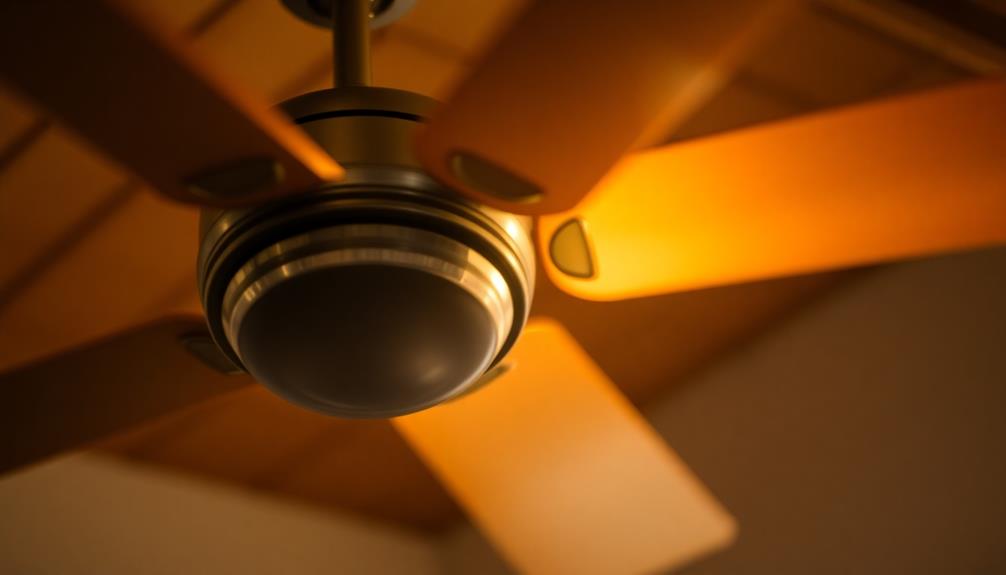
Ceiling fan humming can be a frustrating experience that disrupts your peace at home. Understanding why this noise occurs is essential for maintaining your comfort.
Typically, humming stems from vibrations caused by various factors, including loose components, imbalanced blades, or motor issues. When screws and bolts are loose, even a subtle breeze can create annoying sounds.
Similarly, if the blades aren't aligned properly, they can cause uneven airflow, amplifying the noise. Additionally, motor problems can lead to persistent humming, often indicating wear and tear.
Recognizing these potential causes can help you take action before the issue escalates. By keeping your ceiling fan in good shape, you can enjoy a quieter and more peaceful environment.
Common Causes of Humming
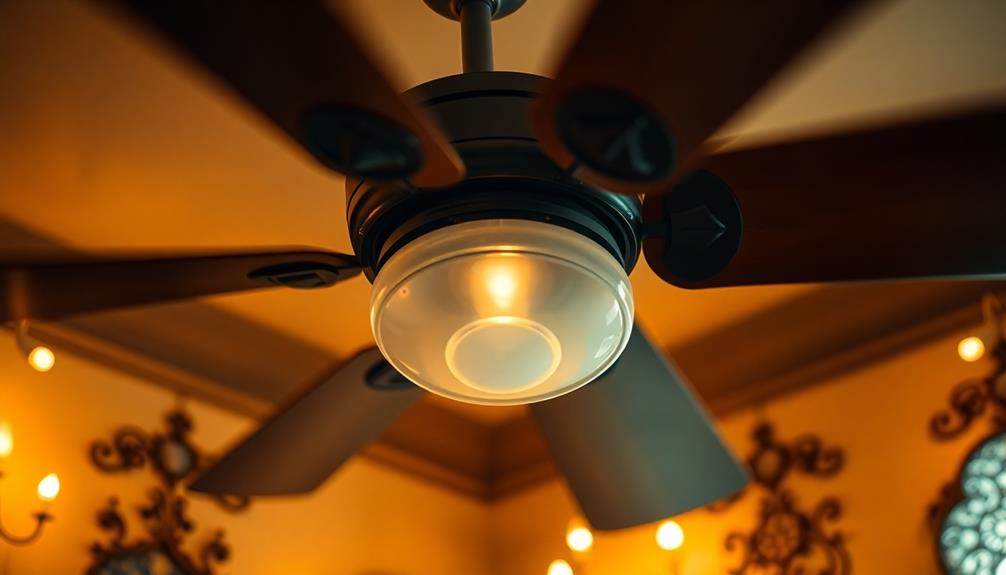
Many homeowners encounter humming from their ceiling fans without realizing the underlying issues that cause it. This annoying noise often stems from several common factors.
| Cause | Description |
|---|---|
| Loose Components | Vibrations from loose screws or bolts can cause humming. |
| Imbalanced Blades | Misaligned blades lead to uneven airflow, creating noise. |
| Motor Problems | Issues like worn bearings or loose mounts can generate humming. |
| Environmental Factors | Airflow obstructions may exacerbate the noise. |
| Electrical Issues | Sudden power surges can also contribute to fan hum. |
Electrical Problems and Remedies
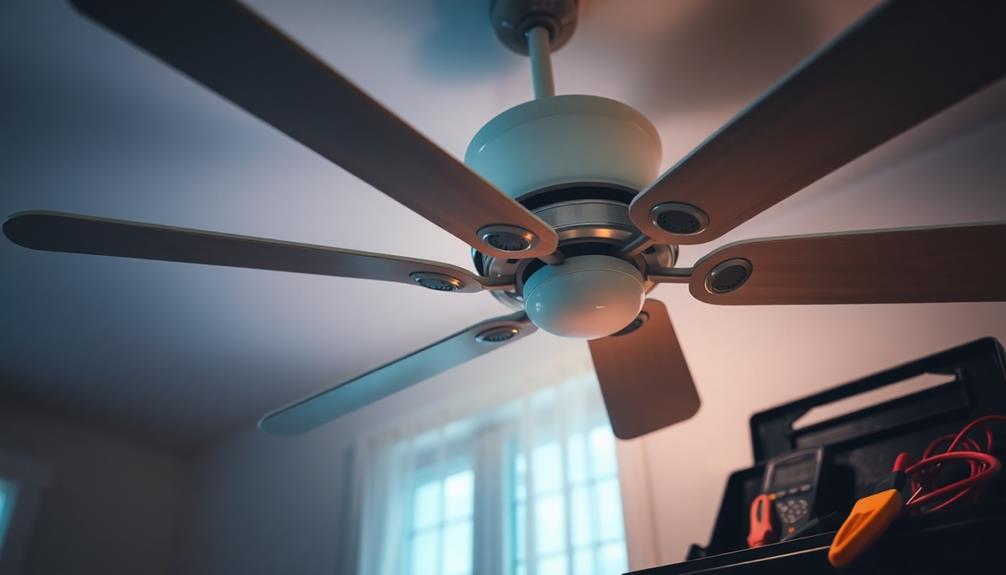
Electrical issues can considerably contribute to humming sounds in ceiling fans, often going unnoticed until they escalate into larger problems. These sounds typically result from loose wiring, faulty connections, or issues with the fan’s motor. Identifying the specific causes of humming fans early on can prevent more severe malfunctions and extend the fan’s lifespan. Regular maintenance and timely repairs are critical to minimizing electrical hazards and ensuring smooth operation.
Power surges can cause vibrations, leading to that annoying hum; using surge protectors can mitigate this risk. If you notice flickering lights or burning smells, it's a sign of faulty wiring, and you should call a professional for inspection.
Regular electrical maintenance is essential—ensure all connections are secure to prevent humming. Additionally, check for loose components and tighten any screws or bolts.
Addressing these electrical problems promptly not only reduces noise but also enhances your fan's longevity and performance.
Don't let humming disrupt your comfort; tackle these issues before they worsen.
Maintenance Tips for Quiet Operation
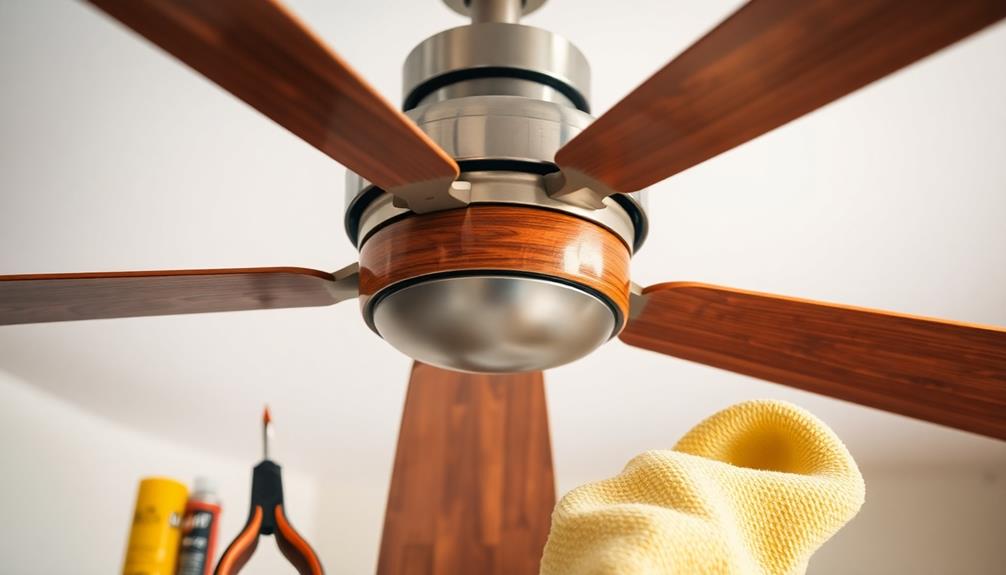
To keep your ceiling fan humming quietly, regular maintenance is key.
Start by cleaning the fan blades regularly to remove dust and debris that can cause noise. Next, check for loose screws and bolts; tightening them can greatly reduce vibrations.
Lubricate the motor and any moving parts to minimize friction and noise. You should also inspect the mounting bracket to make certain it's secure, as a loose mount can lead to humming.
If you notice any unusual sounds, troubleshoot by looking for imbalances or damaged components.
Performing these simple tasks will enhance your fan's performance and help maintain a peaceful environment in your home.
Regular upkeep goes a long way in making sure your ceiling fan runs smoothly and quietly.
Blade Imbalance and Its Effects
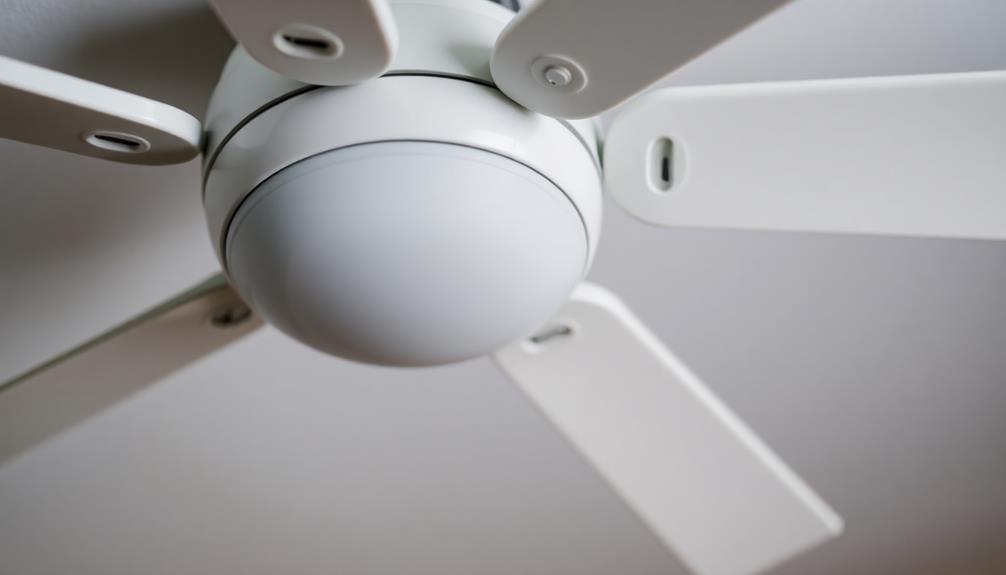
Even with regular maintenance, blade imbalance can still occur and greatly affect your ceiling fan's performance.
When the blades aren't properly aligned, you'll notice uneven air distribution, which can lead to vibrations and, ultimately, that annoying humming sound. This imbalance not only irritates you but can also strain the motor, leading to potential damage over time.
You might find that one side of the room feels stuffy while the other side is breezy, disrupting your comfort.
To fix this, you should regularly check the blade alignment and use a balancing kit if needed. Addressing blade imbalance promptly helps maintain a quiet, efficient ceiling fan, ensuring a pleasant atmosphere in your space. Additionally, keeping the fan free of dust buildup contributes to optimal performance and prevents potential wobbling issues. For those looking to enhance their entertainment setup, reading a **yaber pro v9 projector review** can provide valuable insights into creating a comfortable and immersive movie-watching experience. By maintaining both your ceiling fan and projector, you can ensure a cozy, well-functioning environment for ultimate relaxation.
Influence of Light Bulb Types
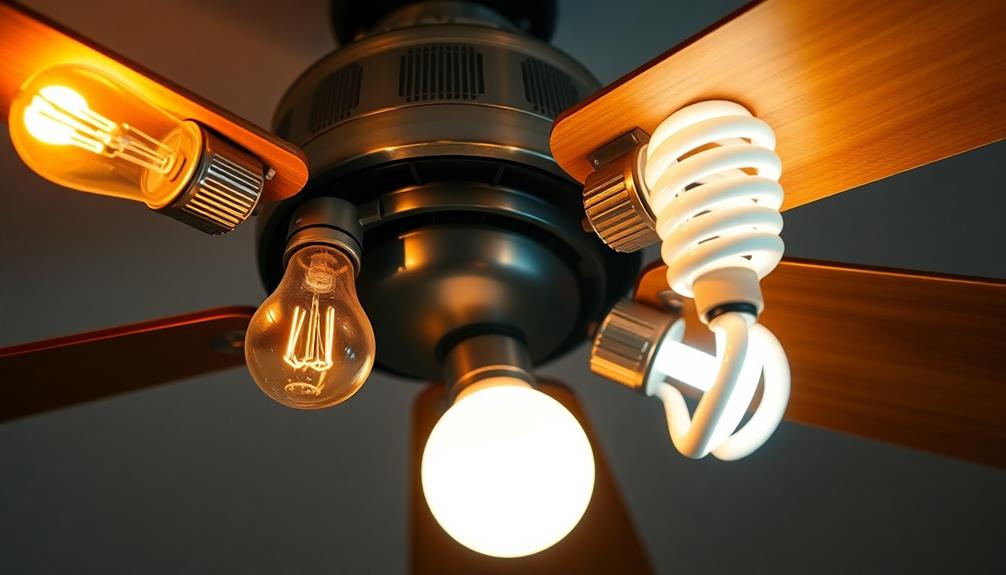
Have you ever noticed how the type of light bulb you use in your ceiling fan can affect its performance? Different bulbs can influence the fan's humming noise.
Incandescent and halogen bulbs tend to generate more heat, which can increase the workload on the fan's motor. This added strain may amplify any existing humming noises.
On the other hand, LED and fluorescent bulbs are more energy-efficient and produce less heat. By choosing these options, you help reduce the fan's workload, potentially minimizing humming sounds.
Additionally, using the right bulb can enhance the overall ambiance of your space without inadvertently contributing to noise issues.
Enhancing Energy Efficiency and Comfort
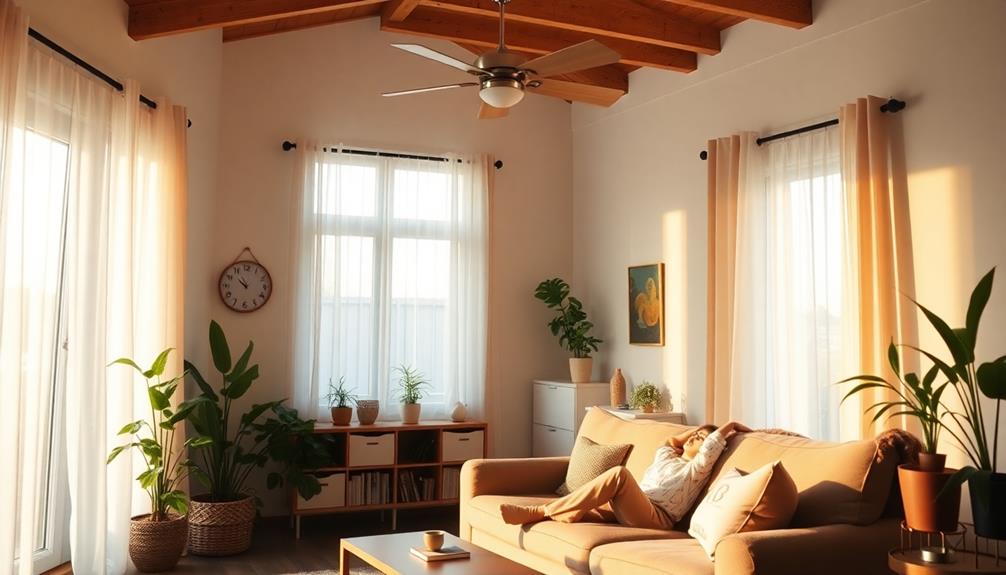
Choosing the right light bulb can greatly influence your ceiling fan's performance, but enhancing energy efficiency and comfort goes beyond just bulb selection. Regular maintenance is key; tightening loose parts and ensuring blade alignment can prevent humming. Additionally, using energy-efficient bulbs reduces heat, lightening the motor's workload and lowering noise.
Here's a quick comparison of bulb types and their impact on efficiency:
| Bulb Type | Energy Efficiency |
|---|---|
| Incandescent | Low |
| Halogen | Moderate |
| LED | High |
| Fluorescent | High |
Frequently Asked Questions
Can Ceiling Fan Humming Affect My Health or Well-Being?
Ceiling fan humming can disrupt your sleep and concentration, potentially affecting your health. You should address the noise for a more peaceful environment, ensuring better rest and overall well-being. Regular maintenance can help minimize disturbances.
Is It Safe to Use a Ceiling Fan While Sleeping?
Yes, it's safe to use a ceiling fan while sleeping. It can help regulate temperature and improve air circulation, promoting better sleep. Just verify it's properly maintained to minimize noise and enhance comfort.
How Can I Tell if My Fan Is Too Noisy?
Your fan's like a whispering breeze; if it turns into a roaring wind, it's too noisy. Listen for humming or rattling sounds, and check for loose parts or imbalances that might be causing disruption.
What Is the Lifespan of a Typical Ceiling Fan?
A typical ceiling fan lasts around 10 to 15 years, depending on usage and maintenance. To maximize its lifespan, keep it clean, lubricate the motor, and check for loose components regularly.
Are There Specific Brands Known for Quieter Ceiling Fans?
Did you know that about 20% of ceiling fans are specifically designed for quieter operation? When choosing brands, look for models from Hunter or Casablanca, known for their innovative designs and reduced noise levels.
Conclusion
In the quest for peace, remember that "an ounce of prevention is worth a pound of cure." By understanding the causes of ceiling fan humming and implementing the right maintenance tips, you can enjoy a quieter, more comfortable space. Whether it's adjusting imbalanced blades or addressing electrical issues, taking these steps guarantees your fan runs smoothly and efficiently. Don't let that annoying hum disrupt your tranquility—act now and restore harmony to your home!
